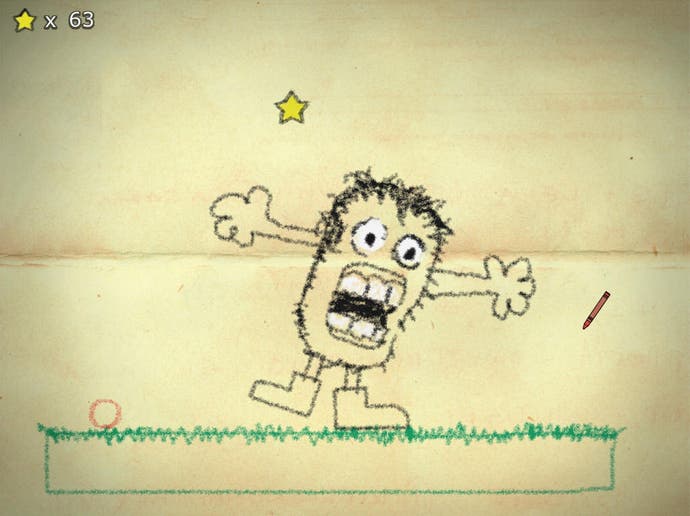Crayon Physics Deluxe
Wax works.
The premise is magical. The screen is a yellowed, unfolded piece of paper, and your mouse cursor is a crayon. What you draw on the paper comes to life. Draw a circle and it will roll down a slope. Draw a line between two points and it becomes string. Attach a hurriedly drawn square to one end, and something you want to lift to the other, and you've made a primitive rope and pulley system. Draw a box with two wheels and there's a little vehicle. The miracle of Crayon Physics Deluxe is that all this works. Like some kind of amazing wizard, you get to draw objects and then immediately see them animated in front of you. What a treat.
This device is made game through a series of levels in which a crude red circle must reach the screen's yellow star or stars. Your direct interaction with the red circle is limited to nudging it left or right with mouse clicks, so your means of moving it are much more about magicking objects into existence. For instance, to reach a higher platform you might trap the ball inside a box, attach that box to a length of string that runs over a tower you've drawn, and then weight it on the other side. The weight tugs the ball up to where you want it, and then a quick right-click of the box makes it disappear and the ball drop.
Or perhaps you could create a catapult. Just a simple single-line drawing of a plough-like shape, with a bucket drawn around the ball and a long line stretching over your triangular pivot, will do the trick. Then draw a big boulder above the far end of the catapult and watch it propel the ball into the air. Or your solution might be to create a lunatic series of strings and pulleys, levers, falling objects, buckets and barriers, resembling the childhood scribblings of Rube Goldberg.

Much has changed since the version that won the Seamus McNally Grand Prize at the 2008 Independent Games Festival. What was formerly a collection of about 30 challenges from a simple menu are now part of a much more realised game. The game's 80 or so levels are arranged in a series of islands, navigated by a child-like drawing of a boat. Collecting enough stars opens later islands, with most levels completed in your chosen order. There's also a lot more you can draw and create. As mentioned, string now works, and there are no limitations on the obscure shapes it can animate, meaning you can add useful notches onto your rectangles, and so on.
In some ways, CPD isn't that original. Since 1993's The Incredible Machine, creating Rube Goldberg/Heath Robinson devices in games has been fairly commonplace. However, previous games gave you a limited set of tools with which to achieve set goals. You'd then have to be inventive within those restrictions, often taking the long way around and having your imagination challenged in the process. Having broken free of these restrictions, the infinite resource of CPD's crayon means the limitations have to be in structures put in place at the start of each level, and it's proved very tricky for that to be enough. You could breeze through the vast majority using the same tricks over and over.


